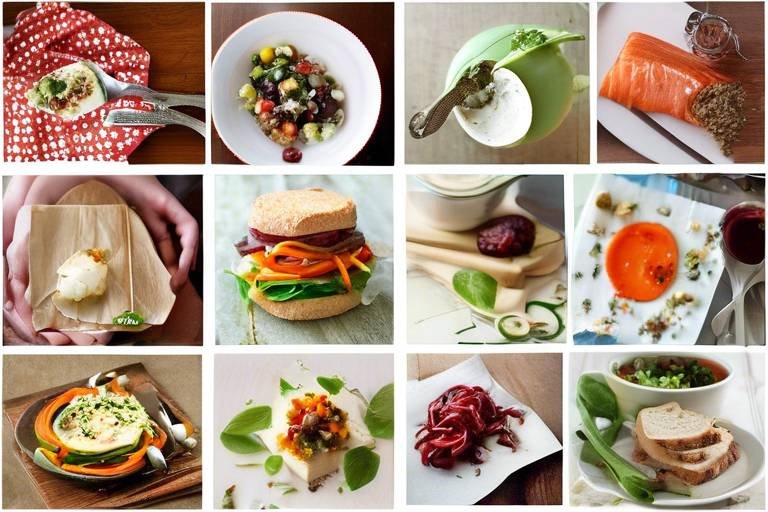The Power of Antioxidants: What Families Need to Know
In today's fast-paced world, where stress and unhealthy eating habits can take a toll on our health, the term antioxidants often pops up in conversations about nutrition and wellness. But what exactly are these magical compounds, and why should families care about them? Antioxidants are substances that help combat oxidative stress in the body, which can lead to cell damage and various diseases. By incorporating more antioxidants into our diets, we can significantly boost our health and well-being.
At their core, antioxidants are like tiny warriors battling free radicals—unstable molecules that can cause havoc in our bodies. Free radicals are produced through natural processes like metabolism, but they can also come from environmental factors such as pollution, UV radiation, and unhealthy diets. Antioxidants neutralize these free radicals, thereby protecting our cells from damage. There are several types of antioxidants, including vitamins (like C and E), minerals (such as selenium), and phytochemicals found in fruits and vegetables. Each type plays a unique role in maintaining our health, and understanding them is the first step in harnessing their power.
So, what are the tangible health benefits of antioxidants? Research suggests that they can help reduce inflammation, boost our immune systems, and even lower the risk of chronic diseases such as heart disease, diabetes, and cancer. Imagine your body as a bustling city; antioxidants are like the dedicated firefighters, extinguishing the flames of inflammation and preventing potential disasters. By keeping inflammation in check, antioxidants help maintain a harmonious balance in our bodies, leading to improved overall health.
One of the most significant areas where antioxidants shine is in promoting heart health. Studies indicate that antioxidants can prevent oxidative damage to blood vessels, which is crucial for maintaining healthy circulation. When our blood vessels are in good shape, we reduce the risk of heart disease significantly. Think of antioxidants as the maintenance crew for your cardiovascular system, ensuring everything runs smoothly and efficiently.
Now that we understand the importance of antioxidants, let's talk about where to find them. Fruits and vegetables are the richest sources of antioxidants, and incorporating a variety into your family's diet can be both delicious and beneficial. Here are some of the top antioxidant-rich options:
- Berries (blueberries, strawberries, raspberries)
- Dark chocolate (yes, it can be healthy!)
- Nuts (especially walnuts and pecans)
- Leafy greens (spinach, kale)
- Artichokes and red beans
By adding these foods to your meals, you not only enhance flavor but also fortify your family's health.
While antioxidants can be found in supplement form, the consensus among health experts is clear: obtaining them from natural food sources is far superior. Whole foods provide a complex mix of nutrients that work synergistically in ways that supplements cannot replicate. Think of it as a symphony; each instrument plays a part, and together they create a beautiful harmony. So, instead of reaching for a pill, opt for a colorful plate filled with fruits and veggies.
As we age, our bodies undergo various changes, and oxidative stress can contribute to the visible signs of aging and cognitive decline. Antioxidants can help combat these effects, preserving skin health and cognitive function. Picture antioxidants as the timekeepers of your body's clock, helping to slow down the aging process and keeping your body functioning optimally.
Now that we know how powerful antioxidants can be, the next question is: how can families easily incorporate them into their daily meals? The good news is that it doesn't have to be complicated! Start by making small changes, such as swapping out snacks for a handful of nuts or a piece of fruit. You can also experiment with colorful salads, smoothies packed with berries, and hearty vegetable soups. The key is to make healthy eating enjoyable and accessible for everyone.
To get you started, here are a couple of creative recipes that highlight antioxidant-rich ingredients:
1. Berry Blast Smoothie: - Blend together 1 cup of mixed berries, 1 banana, 1 cup of spinach, and 1 cup of almond milk. Enjoy! 2. Colorful Antioxidant Salad: - Toss together mixed greens, cherry tomatoes, avocado, walnuts, and a drizzle of olive oil and balsamic vinegar. Delicious!
When it comes to shopping for antioxidant-rich foods, keep these tips in mind:
- Choose organic when possible to avoid pesticides.
- Look for seasonal produce for the best flavor and nutritional value.
- Read labels to avoid added sugars and preservatives.
By being mindful of your choices, you can ensure that your family is getting the best nutrients possible.
Q: What are the best sources of antioxidants?
A: The best sources include fruits like berries, vegetables like leafy greens, nuts, and dark chocolate.
Q: Can I get enough antioxidants from my diet alone?
A: Yes, a balanced diet rich in whole foods can provide all the antioxidants your body needs.
Q: Are supplements necessary?
A: Generally, it's best to get antioxidants from food rather than supplements, as whole foods provide additional nutrients.

Understanding Antioxidants
Antioxidants are like the superheroes of our body, tirelessly battling the villains known as free radicals. But what exactly are they? In simple terms, antioxidants are compounds that help protect our cells from oxidative stress, which is an imbalance between free radicals and antioxidants in the body. When free radicals outnumber antioxidants, they can cause damage to our cells, leading to various health issues.
There are several types of antioxidants, each with unique roles and functions. Some of the most common include:
- Vitamin C: Found in citrus fruits, berries, and leafy greens, this powerhouse vitamin helps neutralize free radicals and regenerate other antioxidants in the body.
- Vitamin E: Often found in nuts, seeds, and vegetable oils, vitamin E is essential for maintaining healthy skin and eyes.
- Beta-carotene: This antioxidant gives carrots and sweet potatoes their vibrant orange color and is converted into vitamin A in the body, supporting vision and immune function.
- Selenium: A mineral found in Brazil nuts, seafood, and whole grains, selenium plays a crucial role in antioxidant enzyme function.
At a cellular level, antioxidants work by donating an electron to free radicals, stabilizing them and preventing them from causing further damage. It's a bit like a game of tag; when a free radical tries to 'tag' a healthy cell, the antioxidant swoops in and stops it, keeping our cells safe and sound. This protective action is vital for maintaining overall health, as oxidative stress has been linked to numerous chronic diseases, including heart disease, cancer, and neurodegenerative disorders.
Understanding the importance of antioxidants is the first step towards a healthier lifestyle. By incorporating antioxidant-rich foods into our diets, we can enhance our body's defenses against oxidative stress and promote long-term wellness. So, what can families do to ensure they are getting enough antioxidants? The answer lies in making informed dietary choices and embracing a colorful plate filled with a variety of fruits and vegetables.

Health Benefits of Antioxidants
Antioxidants are not just a buzzword in health circles; they are essential compounds that play a significant role in maintaining our overall well-being. By neutralizing free radicals, which are harmful molecules that can cause cellular damage, antioxidants help protect our bodies from oxidative stress. This stress is linked to a variety of chronic diseases, including heart disease, diabetes, and even certain types of cancer. So, what exactly are the health benefits of these remarkable compounds? Let's dive deeper!
One of the most notable benefits of antioxidants is their ability to reduce inflammation. Chronic inflammation is like a slow-burning fire in your body, leading to various health issues. Antioxidants, such as vitamin C and vitamin E, help extinguish this fire, promoting a healthier internal environment. Imagine your body as a garden; without proper care, weeds (inflammation) can take over. Antioxidants act as the gardeners, keeping those pesky weeds at bay.
Moreover, antioxidants play a crucial role in boosting the immune system. By enhancing the function of immune cells, they help our bodies fight off infections and diseases more effectively. Think of antioxidants as the body’s defense team, always ready to tackle any invaders that threaten our health. A strong immune system is vital for families, especially during cold and flu season, where the risk of illness can be higher.
Another area where antioxidants shine is in their potential to lower the risk of chronic diseases. Studies have shown that a diet rich in antioxidants can lead to a decreased risk of conditions such as heart disease and cancer. For instance, flavonoids, a type of antioxidant found in berries and citrus fruits, have been linked to improved heart health by reducing blood pressure and improving blood vessel function. It’s like having a shield that protects you from the arrows of chronic illness, making it a vital part of a family’s health strategy.
When it comes to heart health, antioxidants are superheroes! They help prevent oxidative damage to blood vessels, ensuring that blood flows freely and efficiently. This is crucial because when blood vessels are damaged, it can lead to serious conditions like atherosclerosis, where arteries become clogged with plaque. Foods rich in antioxidants, such as berries, nuts, and dark chocolate, can be delicious ways to support your heart. Just think of these foods as tasty little heart protectors, working tirelessly to keep your cardiovascular system in check.
Fruits and vegetables are some of the best sources of antioxidants. Incorporating a variety of these into your family’s diet can be both fun and beneficial. Here are some of the top contenders for antioxidant-rich foods:
- Berries - Blueberries, strawberries, and raspberries are packed with antioxidants and are easy to snack on.
- Leafy Greens - Spinach and kale are not only nutritious but also rich in antioxidants.
- Dark Chocolate - Yes, you read that right! Dark chocolate is loaded with antioxidants, making it a delicious treat.
- Nuts - Almonds and walnuts provide healthy fats along with a good dose of antioxidants.
While antioxidant supplements are widely available, it's essential to consider the benefits of obtaining these compounds from natural food sources. Whole foods provide a synergistic effect, meaning that the nutrients work better together than in isolation. For instance, the antioxidants in fruits and vegetables come with fiber, vitamins, and minerals that all contribute to health. On the other hand, supplements can sometimes lead to imbalances or may not be absorbed as effectively. So, when it comes to antioxidants, think whole foods first!
In conclusion, the health benefits of antioxidants are vast and vital for families looking to boost their overall wellness. From reducing inflammation and enhancing immune function to lowering the risk of chronic diseases, these compounds are essential allies in our health journey. So, why not start incorporating more antioxidant-rich foods into your meals today? Your body will thank you!
Q: What are antioxidants?
A: Antioxidants are compounds that protect the body from oxidative stress by neutralizing free radicals.
Q: How can I incorporate more antioxidants into my diet?
A: You can increase your antioxidant intake by consuming a variety of fruits, vegetables, nuts, and whole grains.
Q: Are supplements necessary for getting enough antioxidants?
A: While supplements can help, it’s best to obtain antioxidants from whole food sources for maximum benefits.
Q: What are some of the best sources of antioxidants?
A: Some of the best sources include berries, leafy greens, nuts, and dark chocolate.

Antioxidants and Heart Health
When it comes to maintaining a healthy heart, antioxidants play a pivotal role that often goes unnoticed. These powerful compounds work tirelessly to combat oxidative stress, which can lead to significant damage in our bodies, especially in our blood vessels. Imagine your blood vessels as highways; just like how traffic jams can cause delays and accidents, oxidative stress can hinder blood flow and lead to serious heart issues. By neutralizing free radicals, antioxidants help keep these highways clear, ensuring smooth circulation and overall cardiovascular health.
Research has shown that a diet rich in antioxidants can help reduce the risk of heart disease. For instance, antioxidants such as vitamin C, vitamin E, and beta-carotene have been linked to improved heart health. They assist in lowering blood pressure, reducing inflammation, and preventing the oxidation of LDL cholesterol, which is often referred to as "bad" cholesterol. When LDL cholesterol oxidizes, it can lead to plaque buildup in the arteries, increasing the risk of heart attacks and strokes. Therefore, incorporating antioxidant-rich foods into your diet could be a game-changer for heart health.
But where can you find these heart-healthy antioxidants? The answer lies in the colorful world of fruits and vegetables. Foods like berries, dark chocolate, and leafy greens are not only delicious but also packed with antioxidants. For example, blueberries are often hailed as a superfood due to their high levels of anthocyanins, a type of antioxidant that has been shown to improve heart health. Similarly, spinach and kale are loaded with vitamins and minerals that support cardiovascular function. To help you get started, here’s a quick table showcasing some of the best antioxidant sources for heart health:
| Food | Key Antioxidants | Benefits for Heart Health |
|---|---|---|
| Blueberries | Anthocyanins | Lower blood pressure, reduce inflammation |
| Spinach | Vitamins C and E | Improve blood vessel function |
| Dark Chocolate | Flavonoids | Enhance circulation, lower cholesterol |
| Walnuts | Omega-3 Fatty Acids | Reduce inflammation, lower blood pressure |
Incorporating these foods into your family's meals can be a delightful journey. Think of it as an adventure where you not only nourish your body but also enjoy the process of cooking and sharing meals together. Whether it’s a refreshing berry smoothie for breakfast or a vibrant salad topped with spinach and walnuts for lunch, the possibilities are endless.
However, it’s essential to remember that while supplements are available, they shouldn’t replace the nutrients you get from whole foods. The body absorbs nutrients from natural sources more effectively, and the combination of various vitamins and minerals in whole foods works synergistically to provide maximum benefits. So, the next time you’re at the grocery store, think twice before reaching for that antioxidant supplement. Instead, fill your cart with fresh produce and wholesome ingredients that will not only taste great but also promote heart health.
In conclusion, antioxidants are your heart's best friends. By understanding their importance and incorporating a variety of antioxidant-rich foods into your family’s diet, you can pave the way for a healthier heart and a happier life. So why not start today? Your heart will thank you!

Fruits and Vegetables as Sources
When it comes to boosting your family's antioxidant intake, fruits and vegetables are your best friends. These colorful foods are not just delicious; they pack a powerful punch of nutrients that can help protect your body from harmful free radicals. But why are these antioxidants so essential? Well, think of antioxidants as the body’s little warriors, fighting off the bad guys that can lead to health issues. They help keep our cells healthy and functioning properly, which is crucial for overall well-being.
To maximize the benefits, it’s important to choose a variety of fruits and vegetables. Each type has its unique set of antioxidants, so mixing it up is key. For instance, berries like blueberries and strawberries are loaded with anthocyanins, which are known for their anti-inflammatory properties. On the other hand, leafy greens such as spinach and kale are rich in vitamins A, C, and E, all of which contribute to a robust immune system. The more colors you add to your plate, the better!
Here’s a quick overview of some antioxidant-rich fruits and vegetables you might want to consider:
| Fruit/Vegetable | Main Antioxidants | Health Benefits |
|---|---|---|
| Blueberries | Anthocyanins | Improve memory and heart health |
| Spinach | Vitamins A, C, E | Boosts immune function and skin health |
| Broccoli | Glucosinolates | Supports detoxification and reduces cancer risk |
| Carrots | Beta-carotene | Promotes eye health and skin protection |
| Oranges | Vitamin C | Enhances immune response and skin health |
Incorporating these foods into your meals doesn’t have to be a chore. For example, tossing some spinach into your morning smoothie or snacking on a handful of berries can be a fun and easy way to boost your antioxidant intake. You can also experiment with colorful salads or stir-fries that combine various vegetables, ensuring you're getting a wide range of nutrients. Remember, the goal is to make healthy eating enjoyable and accessible for the whole family!
So, the next time you're at the grocery store, reach for those vibrant fruits and veggies. They’re not just pretty to look at; they’re essential for keeping your family healthy and happy. And let’s face it, who wouldn’t want to add a splash of color to their meals while reaping such fantastic health benefits?
- What are antioxidants? Antioxidants are compounds that help protect your cells from damage caused by free radicals.
- How do I know which fruits and vegetables are high in antioxidants? Look for colorful options! Generally, the more vibrant the color, the higher the antioxidant content.
- Can I get enough antioxidants from supplements? While supplements can help, it's best to get antioxidants from whole foods for maximum benefits.
- How can I incorporate more fruits and vegetables into my family's diet? Try adding them to smoothies, salads, or stir-fries, and make them accessible as snacks.

Supplements vs. Natural Sources
When it comes to antioxidants, the debate between supplements and natural sources is a hot topic among health enthusiasts and families alike. On one hand, supplements offer a convenient way to boost your antioxidant intake, especially for those who might struggle to consume enough fruits and vegetables in their diet. Just pop a pill, and you're good to go, right? However, the reality is a bit more complex.
Natural sources of antioxidants, primarily found in fruits, vegetables, and other whole foods, provide a plethora of additional nutrients that supplements simply cannot match. These foods are packed with vitamins, minerals, and fiber, all of which play crucial roles in overall health. For instance, the vibrant colors of fruits and vegetables often indicate the presence of various antioxidants, such as vitamin C, beta-carotene, and flavonoids. Eating a rainbow of produce not only enhances your antioxidant intake but also ensures your body receives a well-rounded nutritional profile.
Moreover, the body tends to absorb and utilize antioxidants from food more effectively than those from supplements. This is largely due to the complex interactions between various nutrients found in whole foods. For example, the presence of fiber in fruits and vegetables can slow down the absorption of sugars and fats, which may enhance the overall health benefits of these foods. In contrast, taking isolated antioxidant supplements may lead to imbalances and could even pose health risks if taken in excessive amounts.
To help illustrate the differences, consider the table below:
| Aspect | Supplements | Natural Sources |
|---|---|---|
| Convenience | Easy to take, quick boost | Requires meal prep, but enjoyable |
| Nutrient Variety | Limited to specific antioxidants | Rich in vitamins, minerals, and fiber |
| Absorption | Less effective absorption | Better absorption and synergy |
| Health Risks | Potential for overdose | Generally safe and balanced |
In summary, while supplements can be a useful addition for some, they should not replace the rich, diverse sources of antioxidants found in nature. Families should prioritize incorporating a variety of colorful fruits and vegetables into their meals to reap the full benefits of antioxidants. After all, there's something wonderfully satisfying about biting into a juicy berry or crunching on a fresh carrot, not to mention the joy of sharing these wholesome foods with loved ones.
As you consider your family's dietary choices, remember that a well-balanced diet rich in whole foods is the best approach to harnessing the power of antioxidants. It's not just about adding a supplement to your routine; it's about creating a lifestyle that embraces health and well-being through the natural goodness of food.
- Can I get enough antioxidants from my diet alone? Yes, a balanced diet rich in fruits, vegetables, nuts, and whole grains can provide all the antioxidants your body needs.
- Are antioxidant supplements safe for everyone? While many people can take them safely, it's best to consult with a healthcare provider, especially if you have underlying health conditions.
- What are some easy ways to add more fruits and vegetables to my family's diet? Try incorporating them into smoothies, salads, or even as snacks. You can also involve kids in meal prep to make it fun!

Antioxidants and Aging
As we journey through life, our bodies undergo various changes, many of which are influenced by the environment and our lifestyle choices. One of the most significant factors contributing to these changes is oxidative stress, which can lead to cellular damage and accelerate the aging process. This is where antioxidants come into play, acting as our body's natural defense against the harmful effects of free radicals. These unstable molecules are produced during normal metabolic processes but can increase due to factors such as pollution, UV radiation, and unhealthy diets. By neutralizing free radicals, antioxidants help preserve our cells, promoting longevity and vitality.
Research has shown that antioxidants can play a crucial role in maintaining skin health as we age. For instance, vitamins C and E, both powerful antioxidants, protect the skin from sun damage and improve its elasticity. They work synergistically to combat the signs of aging, such as fine lines and wrinkles. Moreover, antioxidants like beta-carotene and lycopene, found in colorful fruits and vegetables, can enhance skin tone and texture, giving us that youthful glow. So, the next time you reach for that vibrant berry or leafy green, remember that you’re not just nourishing your body; you’re also investing in your skin's future.
But it’s not just our skin that benefits from antioxidants. Our cognitive function also stands to gain significantly. Studies suggest that antioxidants may help protect brain cells from oxidative stress, potentially lowering the risk of age-related cognitive decline and diseases like Alzheimer’s. Nutrients such as flavonoids, abundant in foods like blueberries and dark chocolate, have been linked to improved memory and cognitive performance. Imagine treating your brain to a delicious chocolate treat while also boosting its health—now that’s a win-win!
To truly harness the power of antioxidants in combating aging, it's essential to adopt a holistic approach. This means incorporating a variety of antioxidant-rich foods into your diet, such as:
- Fruits: Berries, oranges, and grapes
- Vegetables: Spinach, kale, and bell peppers
- Nuts and seeds: Walnuts and sunflower seeds
- Herbs and spices: Turmeric and cinnamon
By filling your plate with a colorful array of these foods, you're not just eating; you're actively fighting the signs of aging and promoting overall health.
In conclusion, the relationship between is profound. By understanding how these powerful compounds work, we can make informed choices that enhance our quality of life as we age. So, let’s embrace a diet rich in antioxidants and celebrate the journey of aging with vitality and grace!
Q1: What are antioxidants?
A1: Antioxidants are compounds that help neutralize free radicals in the body, reducing oxidative stress and preventing cellular damage.
Q2: How do antioxidants help with aging?
A2: Antioxidants protect our cells from damage caused by free radicals, which can lead to signs of aging like wrinkles and cognitive decline.
Q3: Can I get enough antioxidants from my diet?
A3: Yes! A balanced diet rich in fruits, vegetables, nuts, and whole grains can provide ample antioxidants to support your health.
Q4: Are antioxidant supplements effective?
A4: While supplements can provide antioxidants, it’s generally recommended to obtain them from whole foods for better absorption and additional health benefits.

Incorporating Antioxidants into Family Meals
In today's fast-paced world, it can be challenging to ensure that our families are getting enough antioxidants in their diets. However, incorporating these powerful compounds into your meals doesn't have to be a daunting task. In fact, with a little creativity and planning, you can make healthy eating both enjoyable and accessible for everyone at the dinner table. Think of it as a culinary adventure where each meal is an opportunity to explore vibrant flavors and nourishing ingredients that boost health.
One of the simplest ways to start is by making a conscious effort to fill your plate with colorful fruits and vegetables. The more colorful your plate, the more likely you are to consume a variety of antioxidants. For instance, berries, spinach, and carrots are not just visually appealing but are also packed with nutrients. You can create a rainbow salad with mixed greens, cherry tomatoes, blueberries, and shredded carrots, drizzled with a light vinaigrette. This not only looks appetizing but also provides a rich source of antioxidants that can help combat oxidative stress.
Another fun way to incorporate antioxidants is through smoothies. Smoothies are a fantastic way to blend various fruits and vegetables into a delicious drink that the whole family can enjoy. You can experiment with combinations like spinach, banana, and blueberries, or try a tropical mix of mango, pineapple, and kale. Not only are these smoothies refreshing, but they're also an easy way to sneak in those essential nutrients, especially for picky eaters.
When it comes to cooking, consider methods that preserve the antioxidant content of your foods. Steaming vegetables instead of boiling them can help retain their nutrients. You can also roast vegetables like broccoli and sweet potatoes with a drizzle of olive oil and your favorite herbs for a flavorful side dish. This not only enhances their taste but also keeps those antioxidants intact. Additionally, using spices like turmeric and ginger in your dishes can provide a double whammy of flavor and health benefits, as they are also rich in antioxidants.
Don't forget about snacks! Instead of reaching for processed snacks, opt for antioxidant-rich options like dark chocolate, nuts, or hummus with fresh veggies. These snacks are not only healthier but can also be a great way to teach children about making better food choices. You can even involve your kids in the kitchen—let them help you prepare these snacks. This hands-on approach can foster a sense of responsibility and excitement about healthy eating.
To help you get started, here’s a quick table of some antioxidant-rich foods and their benefits:
| Food | Key Antioxidants | Health Benefits |
|---|---|---|
| Berries (Blueberries, Strawberries) | Vitamin C, Anthocyanins | Improve heart health, enhance brain function |
| Dark Chocolate | Flavonoids | Boost mood, lower blood pressure |
| Spinach | Lutein, Vitamin C | Support eye health, reduce inflammation |
| Nuts (Walnuts, Almonds) | Vitamin E, Selenium | Promote heart health, support brain function |
Incorporating antioxidants into your family meals is not just about health; it's about creating memories and fostering a love for wholesome food. So, gather your family, get creative in the kitchen, and enjoy the journey of healthy eating together. Remember, the goal is to make every meal an opportunity to nourish your bodies and strengthen your bond as a family.
- What are antioxidants? Antioxidants are compounds that help protect your body from damage caused by free radicals, which can lead to chronic diseases.
- How can I tell if a food is high in antioxidants? Foods that are vibrant in color, such as fruits and vegetables, typically contain higher levels of antioxidants. Look for deep hues like red, blue, purple, and green.
- Are supplements necessary for antioxidants? While supplements can help, it's generally best to get antioxidants from whole foods, as they provide additional nutrients and benefits.
- Can I overdo it on antioxidants? While antioxidants are beneficial, consuming them in excessive amounts through supplements can lead to adverse effects. A balanced diet is key.

Creative Recipes
When it comes to incorporating antioxidants into your family's meals, creativity is key! Making these nutrient-packed foods exciting can turn an ordinary dinner into a vibrant feast. Let's dive into some delicious recipes that not only taste great but also pack a powerful antioxidant punch. Think of these recipes as your family's secret weapon against oxidative stress!
First up, we have a Berry Blast Smoothie. This refreshing drink is perfect for breakfast or as a midday snack. Simply blend together a cup of mixed berries—like blueberries, strawberries, and raspberries—with a banana, a cup of spinach (trust me, you won’t taste it!), and a cup of almond milk. Not only does this smoothie taste divine, but it's also loaded with vitamins and antioxidants that can help your family start the day on the right foot.
Next, consider whipping up a Colorful Quinoa Salad. Quinoa is a fantastic source of protein and pairs beautifully with a variety of vegetables. Cook one cup of quinoa and let it cool. Then, mix in diced bell peppers, cherry tomatoes, cucumber, and a handful of chopped parsley. Drizzle with olive oil and lemon juice for a zesty dressing. This salad is not only a feast for the eyes with its vibrant colors but also a powerhouse of nutrients that can help keep your family healthy and energized.
For dinner, how about a Roasted Vegetable Medley? Toss together your favorite vegetables—think sweet potatoes, carrots, and Brussels sprouts—with a drizzle of olive oil, salt, and pepper. Roast them in the oven at 400°F (200°C) for about 25-30 minutes until they’re golden and crispy. This dish is not only simple to prepare but also brings out the natural sweetness of the vegetables, making it a hit with both kids and adults alike.
If you’re looking for a dessert that’s both tasty and healthy, try making Dark Chocolate Dipped Strawberries. Melt some dark chocolate (at least 70% cocoa) and dip fresh strawberries into it. Let them cool on parchment paper. Dark chocolate is rich in flavonoids, which are powerful antioxidants. This sweet treat will satisfy your family's cravings while giving them a boost of health benefits!
Lastly, don’t forget about the power of spices! Incorporating spices like turmeric and cinnamon into your meals can enhance flavor while also providing antioxidant benefits. For instance, sprinkle some cinnamon on your morning oatmeal or add turmeric to your soups for an earthy flavor that packs a healthful punch.
By experimenting with these creative recipes, you can easily incorporate antioxidant-rich foods into your family’s diet. Remember, healthy eating doesn’t have to be boring. With a little imagination, you can transform your meals into a delightful experience that nourishes both body and soul!

Shopping Tips for Antioxidants
When it comes to shopping for antioxidants, knowing what to look for can make all the difference in ensuring your family gets the best nutrients possible. First and foremost, always aim for fresh produce. Fresh fruits and vegetables are typically packed with more antioxidants than their canned or frozen counterparts. It's like choosing a vibrant, sun-ripened tomato over a dull, processed one; the difference in flavor and nutrition is night and day!
Next, consider the color of the fruits and vegetables you choose. A good rule of thumb is to "eat the rainbow." Each color represents different types of antioxidants, so by including a variety of colors in your shopping cart, you’re ensuring a broad spectrum of health benefits. For instance, red tomatoes and strawberries are rich in lycopene and vitamin C, while green spinach and kale are loaded with lutein and zeaxanthin. This diversity not only enhances your meals visually but also boosts their nutritional value.
Don't shy away from the organic options when possible. Organic produce tends to have higher antioxidant levels because they are grown without synthetic pesticides and fertilizers. While they might be a bit pricier, think of it as an investment in your family's health. Plus, supporting organic farming helps promote sustainable practices, which is a win-win!
When you're at the store, take a moment to read the labels on packaged foods. Many processed items claim to be "rich in antioxidants," but often, they contain added sugars and preservatives that can negate the health benefits. Instead, focus on whole foods that are naturally rich in antioxidants. A quick glance at the ingredient list can save you from purchasing something that seems healthy but is actually packed with unwanted additives.
Additionally, consider shopping at local farmers' markets. Not only will you find fresh, seasonal produce that’s often picked at peak ripeness, but you’ll also support local farmers. The taste and nutrient density of freshly picked fruits and vegetables are often superior to those that have been shipped long distances. Plus, it’s a fun outing for the family!
Lastly, don't forget about frozen fruits and vegetables. While fresh is best, frozen options can still be a great choice. They are typically frozen shortly after harvesting, preserving their antioxidant content. Just make sure to choose varieties without added sugars or sauces. So, next time you’re in the frozen aisle, don’t overlook those berries or leafy greens!
In summary, shopping for antioxidants can be simple and enjoyable if you keep these tips in mind. By focusing on fresh, colorful, and organic options, and by being mindful of labels, you can easily enhance your family’s diet with powerful antioxidants that promote health and well-being.
- What are antioxidants? Antioxidants are compounds that help neutralize free radicals in the body, reducing oxidative stress and promoting overall health.
- Which foods are highest in antioxidants? Foods like berries, dark chocolate, nuts, and green leafy vegetables are known to be high in antioxidants.
- Are supplements necessary? While supplements can provide antioxidants, it's generally best to obtain them from whole foods for maximum health benefits.
- How can I tell if a food is high in antioxidants? Look for vibrant colors in fruits and vegetables and check for terms like "rich in antioxidants" on labels, but always read the ingredient list.
Frequently Asked Questions
- What are antioxidants and why are they important?
Antioxidants are natural compounds that help protect your body from oxidative stress, which can lead to cell damage. They play a crucial role in maintaining overall health by neutralizing free radicals, potentially reducing the risk of chronic diseases and promoting longevity.
- How can I incorporate more antioxidants into my family's diet?
Incorporating antioxidants into your family's meals can be both fun and delicious! Focus on adding a variety of colorful fruits and vegetables, like berries, spinach, and carrots, to your meals. You can also experiment with nuts, seeds, and whole grains, which are excellent sources of these beneficial compounds.
- Are supplements a good source of antioxidants?
While supplements can provide antioxidants, they are not a substitute for a balanced diet. Whole foods offer a complex mix of nutrients that work together synergistically. It's generally best to aim for a diet rich in fruits, vegetables, and other natural sources to get the full benefits of antioxidants.
- Which fruits and vegetables are the highest in antioxidants?
Some of the top antioxidant-rich fruits and vegetables include blueberries, strawberries, kale, spinach, and artichokes. These foods not only provide a boost of antioxidants but also come packed with vitamins and minerals that support overall health.
- Can antioxidants help with aging?
Absolutely! Antioxidants can combat the effects of aging by protecting your skin from damage and supporting cognitive function. By including antioxidant-rich foods in your diet, you can help maintain youthful skin and promote better brain health as you age.
- What are some easy recipes that include antioxidants?
There are countless delicious recipes that feature antioxidant-rich ingredients! Try making a vibrant berry smoothie, a spinach salad with nuts and seeds, or a hearty vegetable stir-fry. These meals are not only nutritious but also family-friendly and enjoyable!
- How do I choose the best antioxidant-rich foods when shopping?
When shopping for antioxidant-rich foods, look for fresh, colorful produce and read labels carefully. Choose whole foods over processed items, and aim for organic options when possible to maximize the nutrient content. Seasonal fruits and vegetables are often fresher and more flavorful!



















